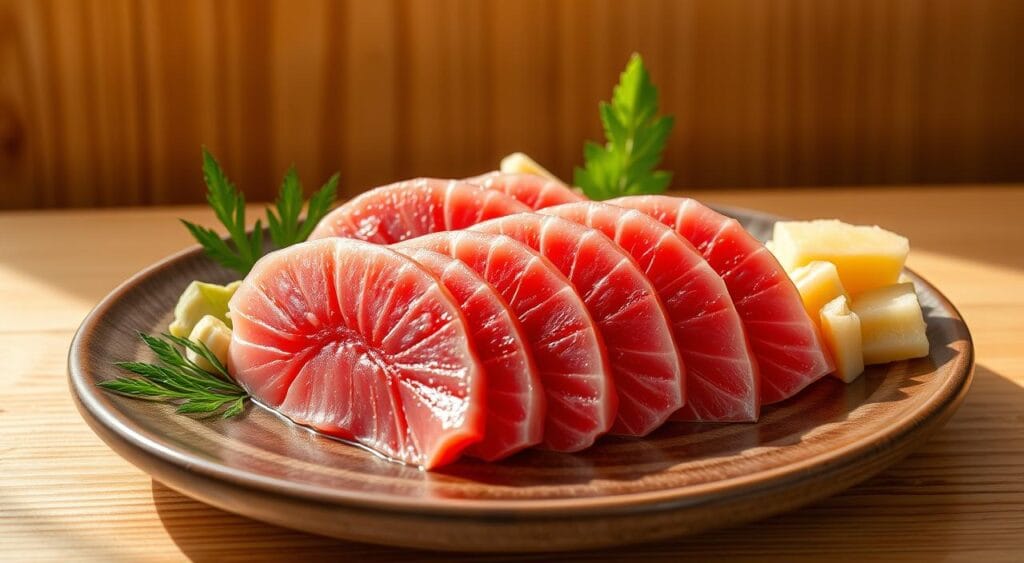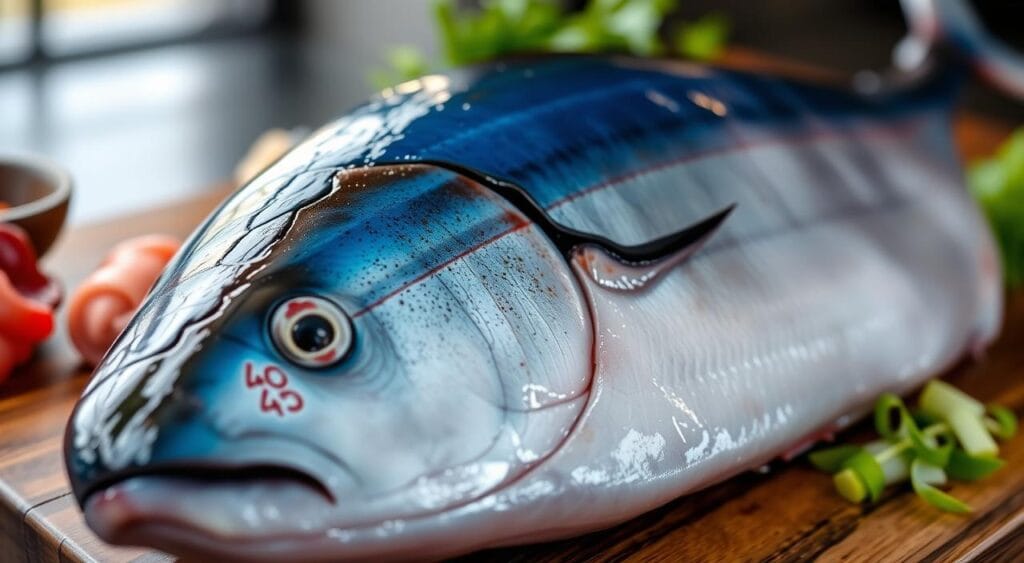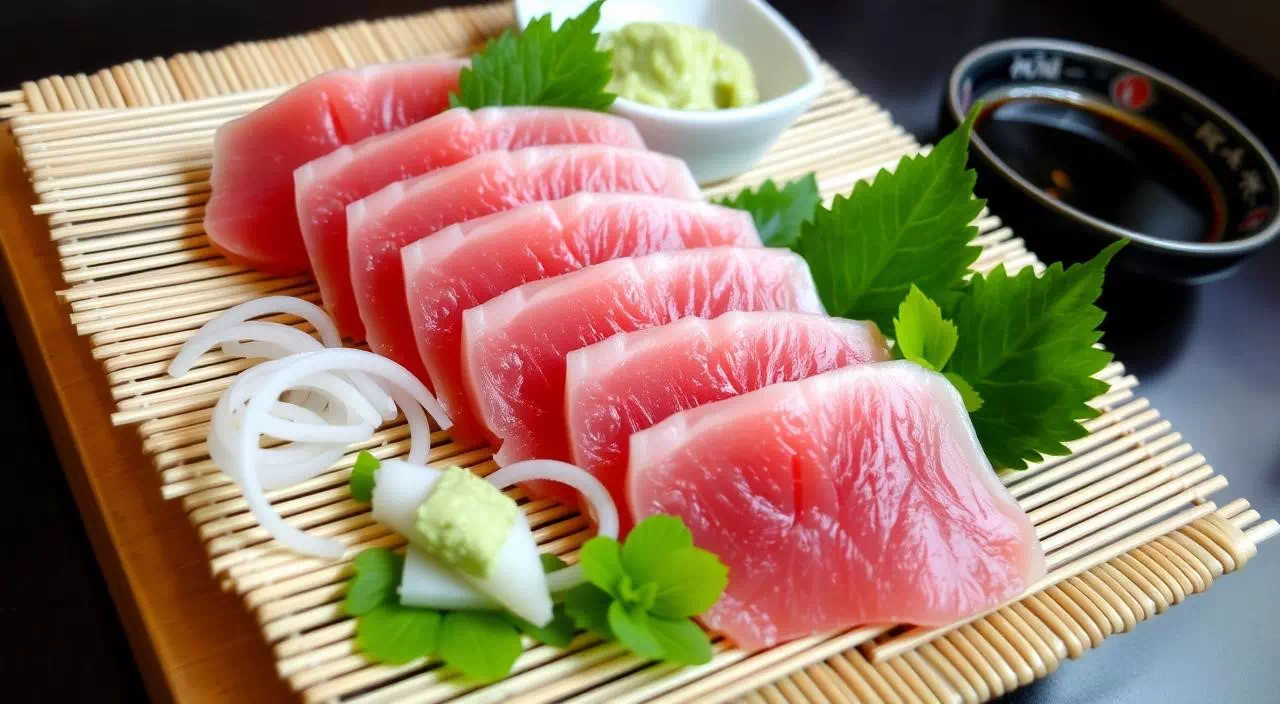When you enter a traditional Japanese restaurant, you’re greeted by the smell of fresh tuna sashimi. It invites you to start a delicious journey. This dish, known for its bright colors and soft tastes, has won the hearts of many around the world. This guide will show you the beauty and details of fresh tuna sashimi.
Tuna sashimi is a key part of Japan’s food culture. It shows Japan’s love for fresh, top-quality ingredients and skill in cutting. There’s Bluefin Tuna, Yellowfin, and Albacore, each with its own taste and texture. This variety meets the needs of many, whether you’re a sashimi expert or just starting out.
Understanding Sashimi: A Traditional Japanese Delicacy
Sashimi is a raw fish dish that’s very special in Japanese cuisine. It shows Japan’s love for fresh and high-quality seafood. This dish started in the Edo period and became known for its beauty and taste.
The Art of Sashimi Preparation
Making sashimi is a detailed process that shows a chef’s skill. Chefs cut the fish carefully to make sure each slice is the same. This lets the fish’s natural taste and texture stand out. Unlike sushi, sashimi doesn’t have rice, focusing on the seafood alone.
Difference Between Sashimi and Sushi
Sashimi and sushi are both loved in Japan, but they’re different. Sashimi is just raw, thin fish slices with soy sauce and wasabi. Sushi has fish on top of rice, making it a bit more complex.
“Sashimi represents the essence of Japan’s culinary artistry, where the purity of the ingredients and the skill of the chef are celebrated in every delicate slice.”
More people around the world are trying sashimi because it’s healthy. They enjoy the taste of sashimi grade tuna and other seafood. Whether at a sushi restaurant or a place that serves Japanese cuisine, sashimi is loved for its taste and look.

Types of Tuna Sashimi
There’s a wide range of tuna sashimi, from the luxurious bluefin tuna to the more budget-friendly albacore tuna. Bluefin tuna is the top choice, known for its soft Otoro (belly) and firm Akami (lean tuna). Yellowfin tuna, or Ahi, has a milder taste and firmer texture. Meanwhile, albacore tuna is lighter in color and softer to eat.
The prices of these tuna types vary a lot. Bluefin tuna is the priciest, while albacore is the cheapest. This means you can find tuna that fits your taste and budget. Whether you love the rich Otoro or the delicate Akami, there’s something for everyone in tuna sashimi.

“Tuna fish can weigh up to 500 pounds, and the different cuts offer unique flavor profiles and textures.”
From the firm bluefin tuna to the tender albacore tuna, each type brings something special to Japanese cuisine. Dive into the world of tuna sashimi and find your favorite.
Essential Quality Markers for Fresh Tuna
Enjoying sashimi grade tuna means the fish quality is key. Whether it’s Bluefin tuna or Yellowfin tuna, knowing what to look for is important. This helps you find the freshest and best fresh tuna.
Color and Appearance
The color of tuna quality can range from deep red to pink. It should always be bright and even. Stay away from tuna that looks dull, dry, or off-color. These signs mean it’s old and not good quality.
Texture and Firmness
Sushis-grade tuna should feel firm and springy when pressed. It should be dense and not soft or mushy. This shows it’s fresh and of high quality.
Aroma and Freshness Indicators
A good sashimi grade tuna smells clean and ocean-like, without a strong fish smell. If it smells bad or strong, it’s likely spoiled or handled wrong.
Remember, sushi-grade tuna is often flash-frozen. This keeps it fresh and safe, ensuring great taste. By knowing these quality signs, you can pick the best fresh tuna for your sashimi.
Proper Cutting Techniques and Presentation
Mastering sashimi preparation needs great knife skills and attention to detail. The secret to perfect sashimi is in the cuts. Use a sharp Japanese knife, like the Yanagiba or Takohiki, to slice the tuna against the grain. This makes thin, even pieces about 1/4 inch thick.
This careful cutting improves the sashimi‘s texture and highlights the fish’s beauty.
The way you present sashimi is just as crucial. It shows the chef’s skill and respect for the ingredients. Place the tuna slices neatly on a clean, chilled platter. Add garnishes like shredded daikon radish, microgreens, or edible flowers for color and texture.
This mix of colors, textures, and flavors makes for a stunning and balanced meal.
“The true essence of sashimi lies in the seamless fusion of technical precision and artistic expression.”
Learning Japanese knife skills for sashimi takes time and effort. But, the outcome is worth it. By honing your cutting and presentation skills, you turn simple sashimi into a feast for the eyes and taste buds.
Traditional Accompaniments and Pairings
Tuna sashimi is a delicate and flavorful Japanese delicacy. It pairs beautifully with various traditional accompaniments and beverages. The key to enhancing its taste is choosing the right complementary elements.
Wasabi and Soy Sauce
No sashimi experience is complete without wasabi and soy sauce. The sharp, pungent flavor of wasabi contrasts the rich tuna. Soy sauce enhances the fish’s natural sweetness and depth.
Garnishes and Additional Condiments
Sashimi is often served with pickled gari (ginger) to cleanse the palate. Microgreens, shredded daikon radish, and shiso leaves are also popular. They add a subtle crunch and herbaceous notes.
Beverage Pairing Suggestions
Sashimi pairs exceptionally well with sake, especially chilled or lightly chilled varieties. The flavors of sake complement the tuna’s delicate nature. Light, refreshing white wines or cold, dry beer are also great sake pairing choices.
“The harmonious combination of sashimi, soy sauce, and wasabi is a quintessential part of Japanese culinary culture.”
Health Benefits and Nutritional Value
Tuna sashimi is a nutritious food choice, rich in high-quality protein and omega-3 fatty acids. It’s low in calories and saturated fat, making it a heart-healthy option. Tuna also provides essential vitamins and minerals, including vitamin D, selenium, and potassium.
The specific tuna species used in sashimi can offer slightly different nutritional profiles. For example, albacore tuna is known for its lighter color and milder flavor, while being a great source of lean protein and omega-3 fatty acids. Bigeye tuna, on the other hand, is richer in flavor and an excellent source of omega-3s due to its higher fat content.
Yellowfin tuna, often found in ahi tuna dishes, is a good source of protein and selenium, contributing to various health benefits. Bluefin tuna is considered one of the fattiest tunas, providing healthy fats and vitamins. Skipjack tuna, commonly used in canned tuna, offers ample amounts of protein and vitamins.
Regardless of the tuna species, sashimi is a protein-rich food that can support muscle building and repair. It’s also low in calories, making it a suitable choice for healthy diet and weight management. The omega-3 fatty acids in tuna are crucial for heart health, brain function, and reducing inflammation.
“Incorporating more seafood, like tuna sashimi, into your diet can aid in weight management efforts and contribute to overall health and well-being.”
However, due to potential mercury content, consumption of tuna sashimi should be moderated, especially for pregnant women and young children. Yellowfin and albacore tuna are often recommended for their lower mercury levels and higher omega-3 fatty acid content, making them healthier options.
Safe Handling and Storage Guidelines
When enjoying fresh tuna sashimi, handling and storage are key. It’s vital to follow temperature and storage guidelines for safety.
Temperature Requirements
Raw tuna for sashimi must stay below 40°F (4°C). This stops harmful bacteria from growing. Freezing tuna at -4°F (-20°C) or below kills parasites.
Storage Duration
Eat tuna sashimi within 24 hours. If longer storage is needed, freeze it. Thaw in the fridge, not at room temperature, for safety.
Food Safety Considerations
Buy tuna from trusted suppliers. They should prove the fish is safe to eat raw. Some tuna, like Albacore and Yellowfin, don’t need freezing.
Good food handling is crucial. Wash hands well and clean surfaces. Keep raw and cooked foods separate. Store all foods, including tuna, in the fridge when not in use.
Where to Source Quality Tuna for Sashimi
Finding the right tuna for your sashimi is key. Whether you’re a sushi pro or new to Japanese food, getting top-notch tuna is vital. Luckily, there are many ways to find the best tuna for your dishes.
Specialty fish markets like Tokyo’s Tsukiji Market are great for finding sushi-grade tuna. These places offer a wide range of fresh seafood, including bluefin tuna. If you can’t visit these markets, look for online seafood suppliers that deliver sushi-grade tuna.
Online stores like Catalina Offshore Products are known for their sushi-grade tuna. They have over 25,000 happy customers. They offer different types of tuna, from fatty o-toro to lean akami. When buying online, ask about the tuna’s origin, how it was handled, and any certifications to ensure quality.
Always choose quality over price when picking tuna for sashimi. Sashimi is a delicate dish, and the tuna’s freshness and purity matter a lot. Working with trusted fish markets or online suppliers can make your sashimi better and more authentic.
Conclusion
Tuna sashimi is the top of Japanese cuisine. It mixes flavor, texture, and looks in a special way. Knowing how to prepare, choose quality, and serve it makes your culinary experience better. Enjoying tuna sashimi at a sushi place or making it at home lets you see Japan’s appreciation of sashimi and culture.
There are different types of tuna sashimi, like Bluefin, Ahi, and Albacore. Each has its own taste and feel. Learning how to make sashimi, knowing what’s good, and adding traditional sides can make you love it more.
Tuna sashimi is loved for its bright colors, soft feel, and great taste. It’s a favorite among sashimi fans everywhere. Start your journey into sashimi appreciation and discover the amazing world of Japanese food.
FAQ
What is tuna sashimi?
Tuna sashimi is a Japanese dish where fresh tuna is thinly sliced and served raw. It’s known for its delicate flavor and texture.
What is the cultural significance of sashimi in Japan?
Sashimi is deeply rooted in Japanese food culture and reflects the country’s love for fresh seafood. Moreover, the way it’s prepared highlights the fish’s natural flavors.
How are different types of tuna used for sashimi?
Different types of tuna are used for sashimi, each with unique flavors and textures. For example, Bluefin tuna is the premium choice. Meanwhile, Yellowfin and Albacore tuna offer distinct tastes.
What are the key indicators of high-quality tuna for sashimi?
High-quality tuna should have vibrant, firm flesh and a clean scent. Its color should be bright, ranging from deep red to pink.
How is sashimi prepared and presented?
Preparing sashimi requires precision and skill. Specifically, the fish is sliced against the grain, about 1/4 inch thick. Furthermore, the presentation is an art, with slices carefully arranged on the plate, often accompanied by garnishes.
What are the traditional accompaniments and pairings for tuna sashimi?
Tuna sashimi is served with soy sauce, wasabi, and pickled ginger. Sake, chilled varieties, complements it well. Beer and certain white wines are also popular.
What are the health benefits of tuna sashimi?
Tuna sashimi is nutritious, rich in protein and omega-3 fatty acids. It’s low in calories and saturated fat, making it heart-healthy. However, due to mercury, moderation is advised, especially for pregnant women and young children.
How should tuna sashimi be stored and handled for safety?
Proper handling of sashimi-grade tuna is key for safety. Specifically, it should be stored at temperatures below 40°F (4°C) and consumed within 24 hours. Additionally, if freezing, use a deep freezer at -4°F (-20°C) or below.
Where can you find high-quality tuna for sashimi?
Quality tuna can be found in specialized fish markets, high-end grocery stores, or online seafood suppliers. Additionally, always ask about the fish’s origin and handling to ensure both quality and safety.
